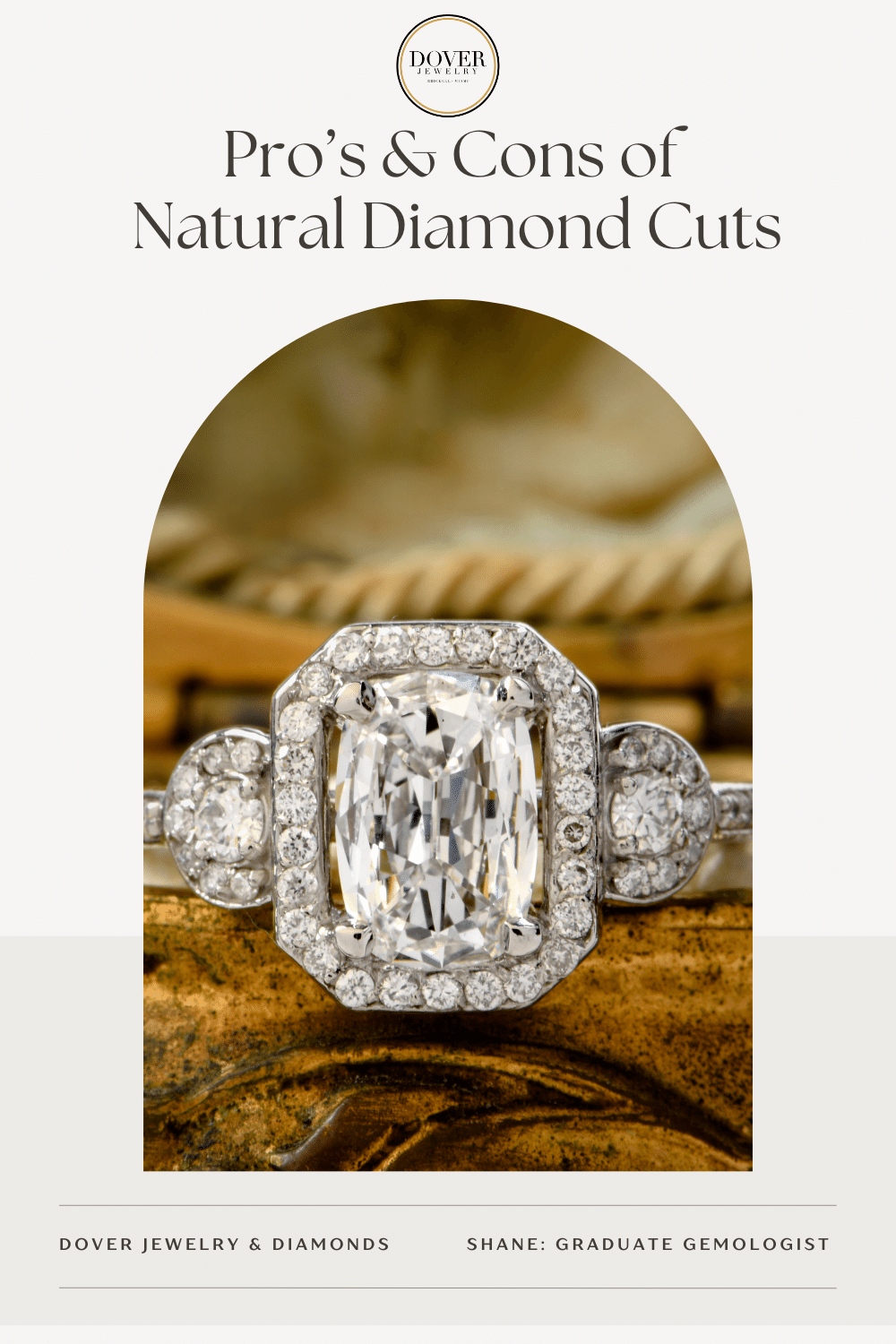
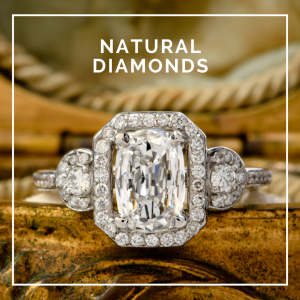 Diamonds have captivated hearts and adorned jewelry for centuries.
Diamonds have captivated hearts and adorned jewelry for centuries.
The world of diamonds is one of beauty, brilliance and endless possibilities, thanks in no small part to the artistry of diamond cutting.
In this blog, we will take you on a journey through some of the most iconic diamond cuts: the Asscher, Round, Oval, Cushion, Marquise and Pear. We’ll also take a look at some of the positives and negatives associated with colored gemstones.
Each of these diamond cuts is a masterpiece in its own right, boasting a unique history, distinctive characteristics, and a set of pros and cons that make them alluring to different tastes and preferences.
Whether you’re drawn to the vintage elegance of the Asscher cut or the timeless brilliance of the round cut, we’ll help you unravel the secrets of these captivating gemstones.
Asscher Cut Diamonds
The Asscher cut, created by the Asscher brothers in the early 20th century, boasts a rich history and unique characteristics.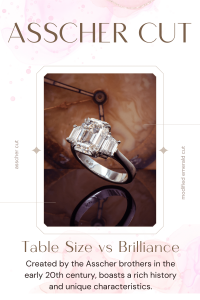
Pros of Asscher Cut Diamonds
- Elegant Vintage Appeal: Asscher cut diamonds exude timeless elegance, often associated with the Art Deco era, making them a classic choice.
- Distinctive Appearance: This cut’s step-cut facets and clipped corners set it apart, creating a striking, eye-catching diamond.
- Clarity Emphasis: Its facets emphasize clarity, making high-quality diamonds with excellent clarity grades ideal for this cut.
- Versatile Settings: Asscher cuts complement various settings, from solitaire rings to vintage designs, allowing for personalization.
- Table Size Brilliance: The table’s size can create a dazzling “hall of mirrors” effect, enhancing brilliance.
Cons of Asscher Cut Diamonds
- Reduced Sparkle: Asscher cuts have fewer facets than some cuts, resulting in less sparkle and fire.
- Visible Inclusions: Inclusions can be more noticeable due to step-cut facets, emphasizing the importance of choosing a high-clarity diamond.
- Shallower Appearance: Some may find Asscher cuts appear smaller for their carat weight due to shallow depth.
- Sharper Corners: Clipped corners can be more susceptible to chipping, demanding extra care.
- Less Common: Asscher cuts are rarer than other shapes, potentially leading to higher prices and availability challenges.
Without a doubt, the Asscher cut diamond is a classic choice with plenty of vintage appeal, thanks to its distinctive appearance, emphasis on clarity, versatility in settings, and the potential for a dazzling “hall of mirrors” effect. However, it does have some drawbacks, including reduced sparkle, more noticeable inclusions, a shallower appearance for its carat weight, susceptibility to chipping at the sharper corners, and its rarity, which may lead to pricing and availability concerns.
Round Cut Diamonds
Round-cut diamonds, often referred to as “brilliant cut” diamonds, are the most popular and classic choice among diamond shapes, with a rich history dating back centuries.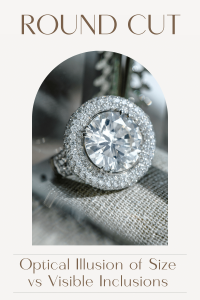
Pros of Round Cut Diamonds
- Exceptional Brilliance: Round diamonds are renowned for their unparalleled brilliance, sparkle, and fire due to their 57 or 58 facets.
- Timeless Appeal: Their enduring popularity makes them a timeless choice, suitable for a wide range of jewelry styles and occasions.
- Versatile Settings: Round diamonds complement various settings, from solitaire engagement rings to elaborate designs.
- Optical Illusion of Size: The brilliant cut can create an optical illusion, making the diamond appear larger than other shapes of the same carat weight.
- Maximized Rarity: The round cut maximizes the rough diamond’s value, as it minimizes wasted material during the cutting process.
Cons of Round Cut Diamonds
- Higher Price: Round diamonds often come at a premium due to their popularity and the extensive cutting process required to achieve their brilliance.
- Visible Inclusions: Due to their high brilliance, inclusions and imperfections may be more noticeable, necessitating a focus on clarity when selecting a diamond.
- Cut Quality Matters: A well-cut round diamond is essential for its beauty. Poorly cut rounds may lack the expected brilliance.
- Potential for Size Trade-Off: To maintain the desired proportions for brilliance, round diamonds may sacrifice carat weight, appearing smaller for their size.
- Less Distinctive: Round diamonds, while classic, may be seen as less distinctive or unique compared to some fancy shapes like the Asscher or pear cuts.
In summary, round-cut diamonds are celebrated for their unmatched brilliance and timeless appeal, but they may come at a higher cost, and the cut quality plays a significant role in their beauty.
Ultimately, personal preference and budget considerations will guide the choice between a round and other diamond shapes.
Oval-Cut Diamonds
Oval cut diamonds are a classic and elegant choice with a history rooted in innovation and style.
Pros of Oval Cut Diamonds
- Elegance and Innovation: The oval cut is an innovative adaptation of the round brilliant cut, designed to maximize brilliance and sparkle.
- Timeless Appeal: Oval diamonds offer a timeless and versatile look, suitable for a wide range of jewelry styles.
- Lengthening Effect: The elongated shape of ovals can create the illusion of longer, more slender fingers, making them popular for engagement rings.
- Brilliance: Oval diamonds exhibit exceptional brilliance and fire due to their multiple facets.
- Unique and Eye-catching: While not as common as round diamonds, ovals offer a unique and eye-catching alternative.
Cons of Oval Cut Diamonds
- Bow-Tie Effect: Some oval diamonds may exhibit a dark or shadowy area in the center, known as the “bow-tie effect,” which can affect their overall appearance.
- Visible Inclusions: Like other brilliant cuts, inclusions may be more noticeable, requiring a focus on clarity.
- Cut Quality: The quality of the oval cut can vary, and poorly cut ovals may lack the expected brilliance.
- Symmetry Matters: Achieving excellent symmetry is crucial for oval diamonds; asymmetrical cuts can detract from their beauty.
- Size Variation: Oval diamonds may appear larger or smaller depending on their proportions, making it important to choose the right size for personal preferences.
As you can see, oval cut diamonds offer a blend of classic elegance and brilliance, with a unique shape that can enhance the appearance of the wearer’s hand. However, careful consideration of cut quality, symmetry, and potential issues like the bow-tie effect is essential when selecting an oval diamond.
Cushion Cut Diamonds
Cushion-cut diamonds are a captivating choice that combines vintage charm with modern brilliance.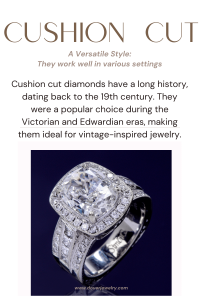
Pros of Cushion Cut Diamonds
- Historical Significance: Cushion-cut diamonds have a long history, dating back to the 19th century. They were a popular choice during the Victorian and Edwardian eras, making them ideal for vintage-inspired jewelry.
- Unique Appearance: The cushion cut features a square or rectangular shape with rounded corners, giving it a distinctive, soft, and romantic appearance.
- Brilliance and Fire: Well-cut cushion diamonds can exhibit impressive brilliance and fire, offering a good balance between sparkle and vintage elegance.
- Versatile Settings: They work well in various settings, from solitaire engagement rings to halo designs, allowing for personalization.
- Face-up Size: Cushion cuts can appear larger for their carat weight due to their larger face-up surface area.
Cons of Cushion Cut Diamonds
- Variance in Cut Styles: Cushion cuts come in various facet patterns, including antique-style and modern, which can affect their brilliance and overall appearance.
- Visible Inclusions: Inclusions may be more noticeable due to the large facets, so choosing a diamond with good clarity is important.
- Shape Variability: Cushion cuts vary in terms of squareness and rectangularity, making it crucial to select the shape that matches your preferences.
- Less Sparkle: While they offer a balance between brilliance and vintage appeal, cushion cuts may not exhibit the same level of sparkle as round or princess cuts.
- Price: High-quality cushion cut diamonds can be expensive due to their popularity and the complexity of cutting to maximize brilliance.
Clearly, cushion-cut diamonds offer a unique blend of vintage charm and modern brilliance, making them an appealing choice for those seeking a distinctive and timeless look. However, careful consideration of cut style, clarity, and personal preferences is necessary when selecting a cushion-cut diamond.
Marquise Cut Diamonds
Marquise cut diamonds known for their elegant and elongated shape, have a fascinating history and a distinctive appearance.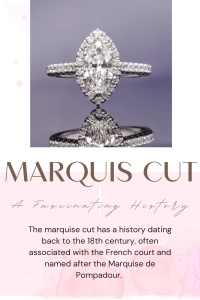
Pros of Marquise Cut Diamonds
- Historical Significance: The Marquise Cut has a history dating back to the 18th century, often associated with the French court and named after the Marquise de Pompadour. Its rich heritage makes it a choice with a touch of historical charm.
- Unique and Eye-Catching: The marquise cut stands out with its elongated shape and pointed ends, creating a unique and eye-catching silhouette.
- Lengthening Effect: The elongated shape can create the illusion of longer and more slender fingers, making it a popular choice for engagement rings.
- Face-up Size: Marquise diamonds typically have a larger face-up appearance than round diamonds of the same carat weight.
- Brilliance: Well-cut marquise diamonds can exhibit excellent brilliance and fire, providing a balance between sparkle and distinctive aesthetics.
Cons of Marquise Cut Diamonds
- Bow-Tie Effect: Some marquise diamonds may display a dark area in the center known as the “bow-tie effect,” which can affect their overall beauty.
- Sharp Points: The pointed ends of marquise diamonds can be delicate and prone to chipping or damage, requiring careful handling.
- Symmetry Matters: Achieving good symmetry is crucial for marquise diamonds; asymmetrical cuts can detract from their appeal.
- Visible Inclusions: Inclusions may be more noticeable due to the large facets, emphasizing the importance of clarity.
- Size Variation: The length-to-width ratio of marquise diamonds varies, so selecting the right proportions to suit personal preferences is essential.
To recap, marquise cut diamonds offer a blend of historical significance, elegant elongation, and potential brilliance. However, it’s crucial to pay attention to factors like symmetry, potential bow-tie effects, and the vulnerability of the pointed ends when considering a marquise-cut diamond.
Pear Cut Diamonds
Pear-cut diamonds, also known as teardrop diamonds, have a unique and elegant shape with a rich history.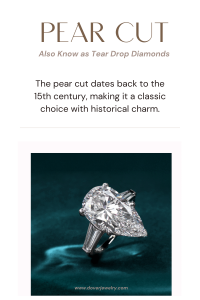
Pros of Pear Cut Diamonds
- Historical Significance: The pear cut dates back to the 15th century, making it a classic choice with historical charm.
- Unique and Eye-Catching: The pear shape combines the round and marquise cuts, creating a distinctive and graceful silhouette that stands out.
- Versatile Design: Pear diamonds are versatile and can be set in various jewelry designs, including engagement rings, pendants, and earrings.
- Face-up Size: The elongated shape often makes pear diamonds appear larger than other shapes of the same carat weight.
- Brilliance: A well-cut pear diamond can exhibit excellent brilliance and fire, offering a balance between sparkle and unique aesthetics.
Cons of Pear Cut Diamonds
- Symmetry Matters: Achieving good symmetry is crucial for pear diamonds; uneven cuts can detract from their beauty.
- Sharp Point: The pointed end of a pear diamond is delicate and prone to chipping or damage,
- Bow-Tie Effect: Some pear diamonds may exhibit a dark area in the center known as the “bow-tie effect,” which can affect their overall appearance.
- Visible Inclusions: Inclusions may be more noticeable due to the large facets, emphasizing the importance of clarity.
- Shape Variability: Pear diamonds come in various length-to-width ratios, so choosing the right proportions to match personal preferences is important.
While pear cut diamonds offer a blend of historical significance, elegance, and potential brilliance. However, it’s crucial to consider factors like symmetry, potential bow-tie effects, and the vulnerability of the pointed end when selecting a pear-cut diamond.
Colored Gemstones
Colored gemstones have a long history of adorning engagement rings, offering a unique and vibrant alternative to traditional diamond center stones.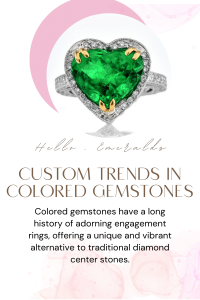
Pros of Colored Gemstones
- Rich History: Colored gemstones like sapphires, rubies, and emeralds have adorned engagement rings for centuries, carrying with them a rich history and symbolism.
- Unique Aesthetics: Colored gemstones offer a wide spectrum of colors, allowing couples to choose a stone that holds personal significance or reflects their unique style.
- Affordability: Colored gemstones can be more budget-friendly than diamonds, allowing for larger or higher-quality stones within a given budget.
- Symbolism: Certain gemstones, like sapphires, are associated with virtues like loyalty and commitment, adding depth to the symbolism of an engagement ring.
- Customization: Colored gemstones can be combined with diamonds or other gems to create custom and meaningful designs.
Cons of Colored Gemstones
- Durability: While many gemstones are durable for everyday wear, they may not be as hard as diamonds and can be more susceptible to scratches and damage.
- Color Fade: Some colored gemstones may exhibit color change or fade over time due to exposure to light or other environmental factors.
- Limited Sparkle: Colored gemstones generally don’t exhibit the same level of brilliance and sparkle as diamonds, which may be a preference for some.
- Inclusion Visibility: Inclusions and imperfections may be more apparent in colored gemstones, affecting their overall appearance.
- Customization Complexity: Customizing a colored gemstone engagement ring may require more effort and expertise to select the right stone and design.
As the focal point of engagement rings, colored gemstones offer a world of diversity, symbolism, and affordability. Yet, they also come with an array of considerations related to durability, maintenance and personal preferences for sparkle and aesthetics. Couples should carefully weigh these pros and cons when choosing a colored gemstone for their engagement ring.
Have More Questions? Just Ask Us!
Choosing the perfect diamond cut or colored gemstone for your engagement ring is a deeply personal decision. Each option brings its own set of characteristics and charm. Just remember, your choice should always reflect your individual style and preferences.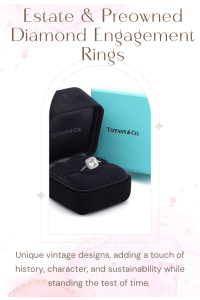
Remember that the beauty of a diamond or gemstone is not solely defined by its cut or shape; it’s also about the meaning and sentiment it holds for you and your loved one. So, explore your options, consider the pros and cons, and select the one that resonates with your heart.
If you have any questions about diamond cuts, or color gemstones, or would just like to know more about our current selection of engagement rings, please contact us today! We’re happy to help with all your vintage jewelry needs!


